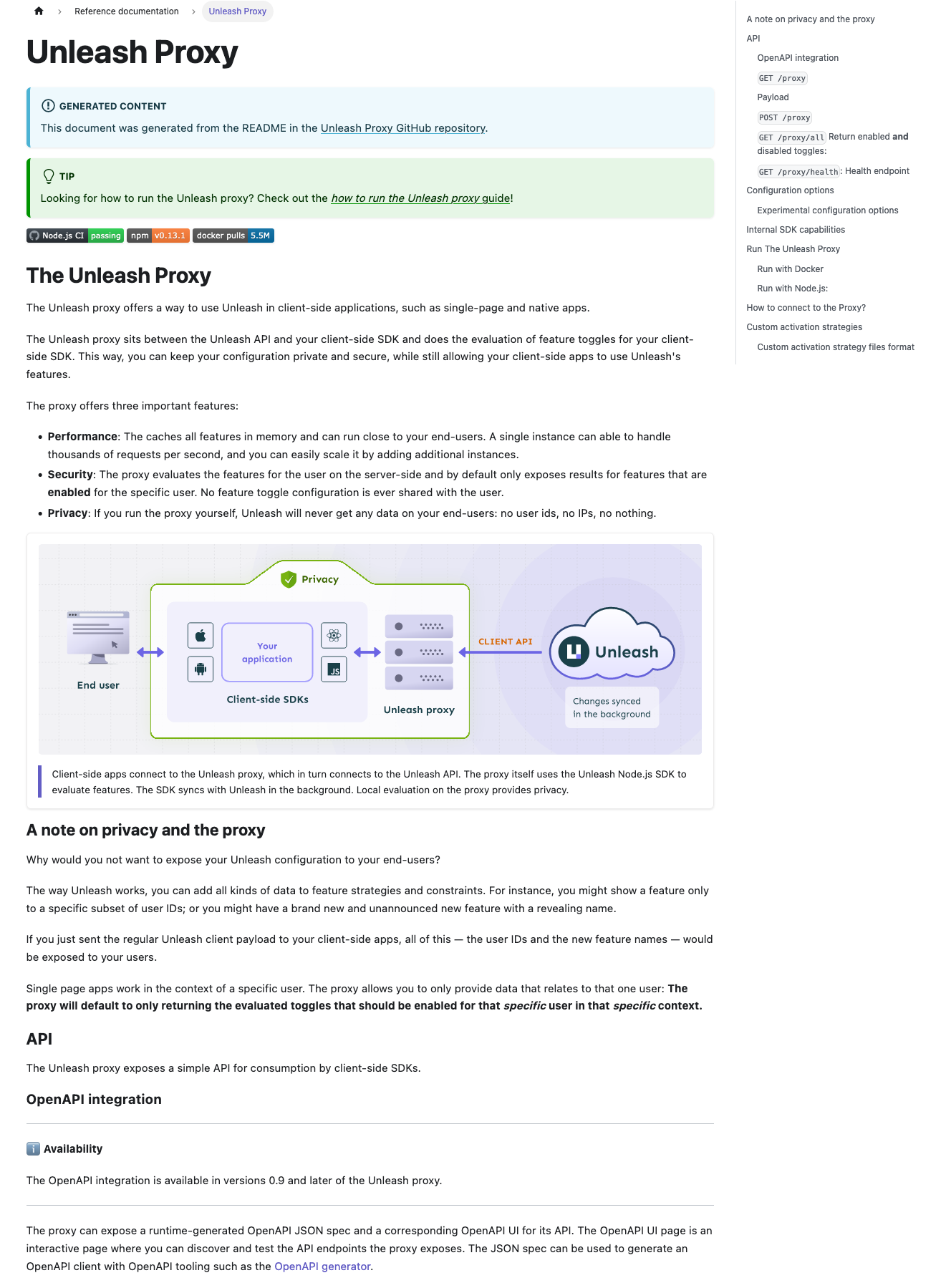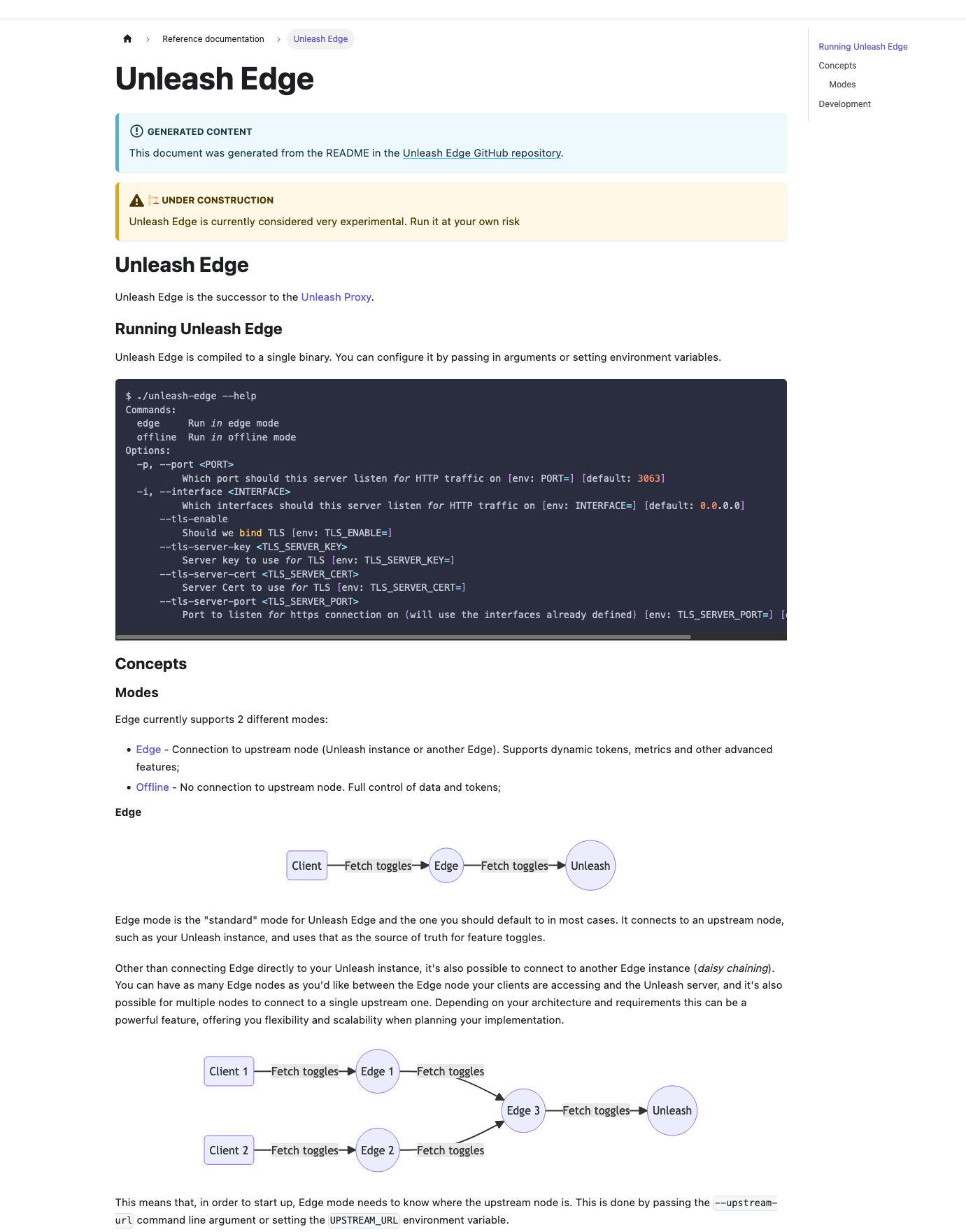## What The main purpose of this PR is to 1. Delete the proxy docs in this repo and replace them with the proxy's GitHub readme. 2. Add the docs for Unleash Edge. ### Detailed change description This PR contains a lot of small changes in a large number of files. To make it easier to get an overview, here's a detailed description of what happens where: #### In the `website/docs`directory Except for the deletion of the proxy doc, all changes in this directory are rewriting internal links, so that they point to the newly generated document instead. #### `package.json` and `yarn.lock` When including the documentation for Edge, we also want to render the mermaid diagrams it uses. Docusaurus supports this via a plugin. All changes in these files are related to installing that plugin. #### `docusaurus.config.js` There's two types of changes in this file: 1. Mermaid-related changes: we ask docusaurus to render mermaid in markdown files and add the plugin 2. Document generation. There's some rewrites to the sdk doc generation plus an entirely new section that generates docs for Edge and the proxy #### `sidebars.js` Two things: 1. Add the edge docs 2. Move both the Edge and the proxy docs up a level, so that they're directly under "reference docs" instead of nested inside "unleash concepts". #### In the `website/remote-content` directory These are the remote content files. Previously, all of this lived only in a `readme-fns.js` file, but with the introduction of Edge and proxy docs, this has been moved into its own directory and refactored into three files (`shared`, `sdks`, `edge-proxy`). #### `custom.css` Style updates to center mermaid diagrams and provide more space around them. #### In `static/img` The image files that were included in the proxy doc and that have been deleted. ## Why For two reasons: 1. Reduce duplication for the proxy. Have one source of truth. 2. Add docs for edge. ## Discussion points and review wishes This is a big PR, and I don't expect anyone to do a line-by-line review of it, nor do I think that is particularly useful. Instead, I'd like to ask reviewers to: 1. Visit the [documentation preview](https://unleash-docs-git-docs-source-proxy-gh-unleash-team.vercel.app/reference/unleash-proxy) and have a look at both the proxy docs and the Edge docs. Potentially have a look at the SDK docs too to verify that everything still works. 2. Consider whether they think moving the proxy and edge docs up a level (in the sidebar) makes sense. 3. Let me know what slug they'd prefer for the Edge docs. I've gone with `unleash-edge` for now (so that it's `docs.getunleash.io/reference/unleash-edge`), but we could potentially also just use `edge`. WDYT? 4. Read through the detailed changes section. 5. Let me know if they have any other concerns or questions. ## Screenies The new proxy doc:  The new edge doc: 
3.0 KiB
| title |
|---|
| Unleash introductory overview |
One of the most important aspects of the architecture to understand is that feature toggles are evaluated in a client SDKs which runs as part of your application. This makes toggle evaluations super-fast (we're talking nano-seconds), scalable and resilient against network disturbances. In order to achieve this Unleash compromises a small update-delay when you change your toggle configurations until it is fully propagated to your application (in terms of seconds and is configurable).
If you want more details you can read about our unique architecture.
Unleash Server
Before you can connect your application to Unleash you need a Unleash server. You have a few options available:
- Unleash Open-source
- Unleash Enterprise
System Overview
- The Unleash API - The Unleash instance. This is where you create feature toggles, configure activation strategies, and parameters, etc. The service holding all feature toggles and their configurations. Configurations declare which activation strategies to use and which parameters they should get.
- The Unleash admin UI - The bundled web interface for interacting with the Unleash instance. Manage toggles, define strategies, look at metrics, and much more. Use the UI to create feature toggles, manage project access roles, create API tokens, and more.
- Unleash SDKs - Unleash SDKs integrate into your applications and get feature configurations from the Unleash API. Use them to check whether features are enabled or disabled and to send metrics to the Unleash API. See all our SDKs
- The Unleash proxy - The Unleash proxy sits between front-end and native applications and the Unleash API. You can scale it independently of the Unleash API to handle large request rates without causing issues for the Unleash API.
To be super fast (we're talking nano-seconds), the client SDK caches all feature toggles and their current configuration in memory. The activation strategies are also implemented in the SDK. This makes it really fast to check if a toggle is on or off because it is just a simple function operating on local state, without the need to poll data from the database.
